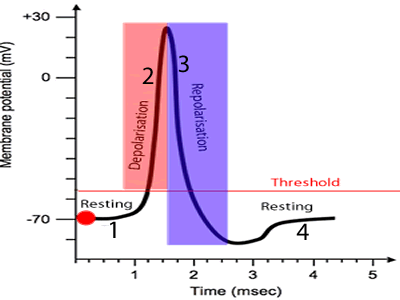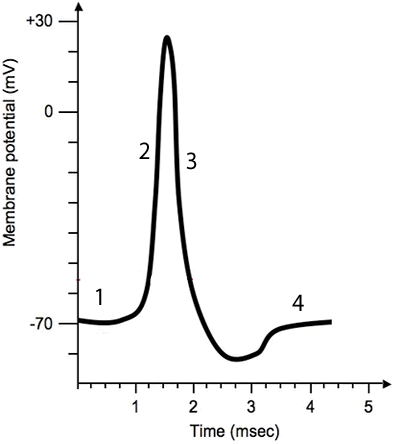When a signal arrives at the axon changes to the membrane take place that make it permeable to positive ions (sodium ions).As a result sodium ions flood into the axon and release a small amount of electrical energy. This causes the membrane just ahead of the signal to become permeable to sodium ions. This continues along the length of the axon. As soon as the sodium ions enter the axon they are pumped out of the axon and the membrane becomes impermeable to sodium ions once again at the site just behind the signal. The animation on the right shows the sequence of events related to the transmission of the electrical signal along the axon.
Special sodium-potasium ion pumps restore the concentration gradient of sodium and potassium ions after a signal has travelled past. The extracellular fluid surrounding the nerve has a high sodium concentration and contains some negative chloride ions. Whereas the intracellular fluid is high in potassium and contains negative phosphate ions.
The resting nerve experiences some movement of ions across its membrane but the concentrations are quickly restored by special proteins such as the sodium-potassium pumps working all the time.

The image on the right shows the changing membrane potential, at one point along the membrane associated with a nerve impulse (action potential). Threshold indicates the degree of polarisation needed to generate the signal. The signal is said to be an all-or-none response, as soon as depolarisation reaches the threshold level a signal is generated.
Looking at the action potential we see the resting, depolarisation and repolarisation stages.
- At rest the exterior of the membrane is more positive than the inside due to a higher concentration of positive ions outside than inside the cell. The concentration difference is maintained by the sodium-potassium pump that uses energy to pump sodium, the occasionally leaks in, out and potassium into the cell.
- Depolarisation occurs when sodium gates open causing an influx of positive sodium into the cell. This now makes the inside of the membrane more positive than the outside.
- Repolarisation occurs when potassium gates open allowing for potassium ions to flow out of the cell, thus restoring the resting potential of the cell.
- Sodium-potassium pumps use ATP to pump sodium ions out of the cell and potassium ions into the cell, thus restoring the original concentration of ions.
Click to see an animation of the action potential and gate opening.

The animation above shows the membrane activity on one side of the axon.
Both sides participate in transmitting the signal. The video on the left shows an animation of the action potential travelling down an axon.
The membrane of the nerve cell has special gates that open and shut to allow sodium ions into the cell and potassium ions out of the cell along a concentration gradient. It also has a pump that uses energy (ATP) to pump potassium ions in and sodium ions out.
Initially the nerve cell is polarised this is where positive sodium ions are at a higher concentrations outside the cell membrane than inside the cell.
When the signal arrives the membrane becomes depolarised as sodium gates open and sodium ions flow into the cell.
When the signal passes, sodium gates close and potassium gates open to allow the outward flow of potassium ions, this is known as repolarisation. After repolarisation the concentration of sodium ions is greater on the inside than on the outside. A special protein pump uses energy to pump sodium out and potassium into the cell.
View the animation on the right.
1) A resting nerve cell has a buildup of sodium ions
and buildup of
inside the cell.
2) The
first step in initiating an action potential is called depolarisation. Depolarisation is when sodium ions
3)
When the nerve cell repolarizes
causing an outflow of
.
4) The sodium-potassium ion pump is constantly working to and against a concentration gradient. This is .
5) What is the function of a nerve cell?
6) Explain the mechanism by which an action potential is propagated along the nerve.
7) What happens to the sodium gates when the nerve is resting?
8) The signal is propagated along the nerve in only one direction.
9) Explain why the action potential travels in one direction along the axon and not in both directions along the axon?
from http://outreach.mcb.harvard.edu/animations/actionpotential.swf
Consider the action potential shown on the right.
Which of one the following is true at 1)?
Which of one the following is true at 2)?
Which of one the following is true at 3)?
Which of one the following is true at 4)?
Which of one the following is true at 2)?
